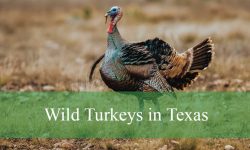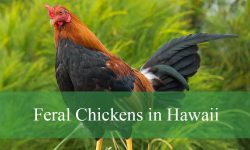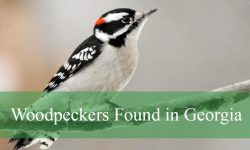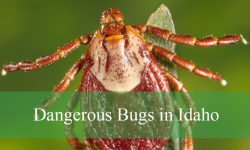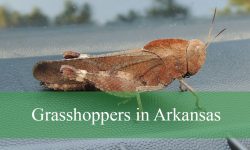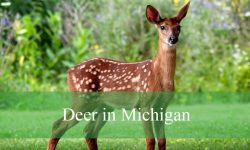Alabama’s lakes, rivers, and wetlands come alive each year with the sound of geese echoing through the morning mist. These graceful birds can be seen gliding across calm waters or grazing in open fields, creating one of the most peaceful sights in southern birdwatching. From shimmering white Snow Geese to the ever-present Canada Goose, the state offers an impressive mix of both resident and migratory species.
As the cooler months arrive, flocks begin to gather across the Tennessee River Valley, Wheeler National Wildlife Refuge, and along coastal marshes near Mobile Bay. Bird enthusiasts can often spot large groups resting on the water or flying overhead in their classic V-shaped formation, signaling the rhythm of the changing seasons.
This guide introduces 10 types of geese in Alabama, featuring detailed identification tips, behavior notes, and habitat insights. Each species, from the familiar to the rare, adds to the state’s rich birdlife and offers endless opportunities for observation and appreciation.
Different Types of Geese Found in Alabama
Canada Goose (Branta canadensis)
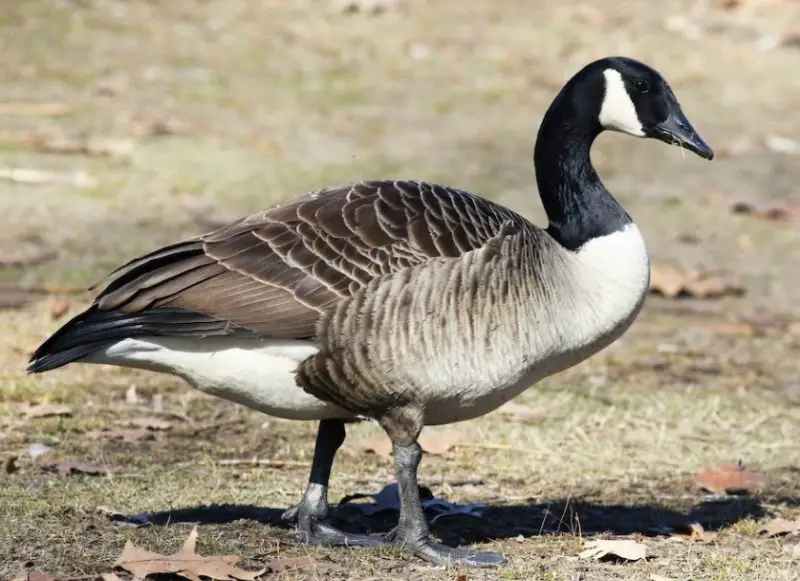
The Canada Goose is one of the most recognizable waterfowl species in North America and is a familiar sight across Alabama throughout the year. These large geese display a striking black head and neck contrasted by a white “chinstrap,” along with a brownish-gray body and pale underparts. Adults typically range from 30 to 43 inches in length and can weigh between 7 and 14 pounds, with an impressive wingspan of up to 6 feet. Males and females look alike, though males are slightly larger. Their loud honking calls are a hallmark of their social communication, especially during migration.
Behaviorally, Canada Geese are highly adaptable and intelligent birds. They form lifelong pair bonds and are known for their strong sense of family; both parents are involved in raising the young. During migration, they fly in the characteristic V-shaped formation, which helps conserve energy and maintain group cohesion. In Alabama, however, many populations have become resident, living year-round around lakes, golf courses, and city parks where food and safety are abundant. Their diet mainly consists of grasses, grains, and aquatic plants.
These geese prefer habitats near freshwater bodies such as ponds, rivers, reservoirs, and marshes. They thrive in both rural and urban settings, often grazing in open grassy areas near water. Canada Geese have adapted remarkably well to human-altered environments, which has led to increased local populations. Their nesting sites are usually located close to water, often on islands or shorelines, where females lay 4 to 7 eggs per clutch.
During the breeding season, which begins in early spring, pairs aggressively defend their territory from intruders. The female incubates the eggs for about 25 to 30 days, while the male guards the area. Once hatched, goslings are precocial and able to walk and swim within 24 hours. Families remain together until fall migration or throughout the year in resident populations. The combination of strong parental care and adaptability has made the Canada Goose one of the most successful species in North America.
Snow Goose (Anser caerulescens)
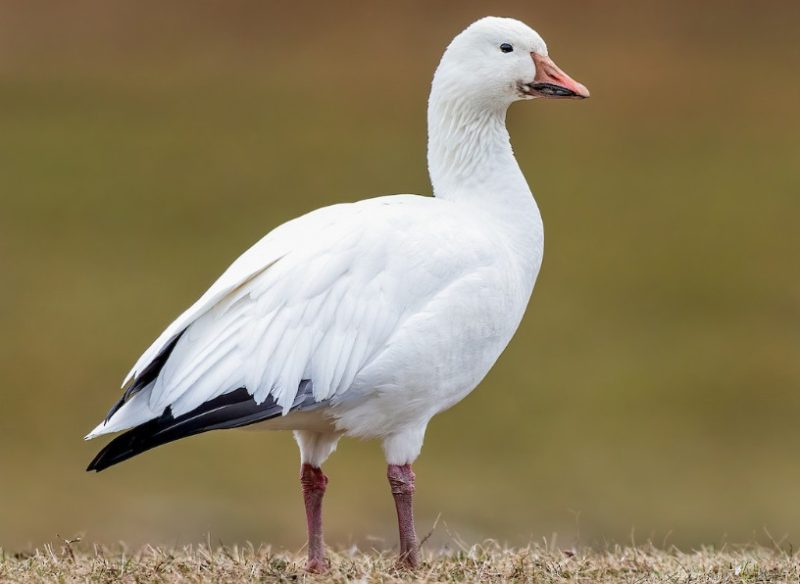
The Snow Goose is a striking migratory bird that visits Alabama mainly during the winter months. It is easily identified by its white plumage contrasted with black wingtips that are visible during flight. Some individuals appear in a “blue morph,” which shows grayish-blue bodies and white heads, creating an interesting color variation within flocks. Adults typically measure about 27 to 33 inches in length, weigh between 4.5 and 7 pounds, and have a wingspan of roughly 54 inches. Their bills are pink with a distinct black “grin patch,” a feature that helps distinguish them from similar species.
Snow Geese are known for their incredible migratory behavior, traveling thousands of miles from Arctic breeding grounds to southern wintering areas, including parts of Alabama. They migrate in large flocks that can number in the thousands, often flying in organized V-formations. These geese are very vocal, producing a high-pitched, nasal honking sound that can be heard from great distances. Their synchronized takeoffs and landings over fields or wetlands are a breathtaking spectacle during migration season.
Their preferred habitats include open wetlands, lakes, flooded fields, and agricultural areas where they forage for food. They feed primarily on grasses, roots, grains, and waste crops such as corn or rice. In Alabama, they are often seen resting or feeding alongside other waterfowl species during the colder months. Because of their large flock behavior and grazing habits, they can sometimes cause crop damage, but they also play an important ecological role by fertilizing soil and aerating wetlands.
Breeding takes place in the Arctic tundra, where females construct shallow nests lined with down feathers. A clutch usually consists of 3 to 5 eggs, and incubation lasts about 23 days. Both parents guard their offspring fiercely, guiding the young to feeding grounds soon after hatching. Snow Geese are long-lived birds, often surviving over a decade in the wild. Their combination of endurance, social organization, and adaptability to different climates makes them one of the most iconic migratory species in North America.
Ross’s Goose (Anser rossii)
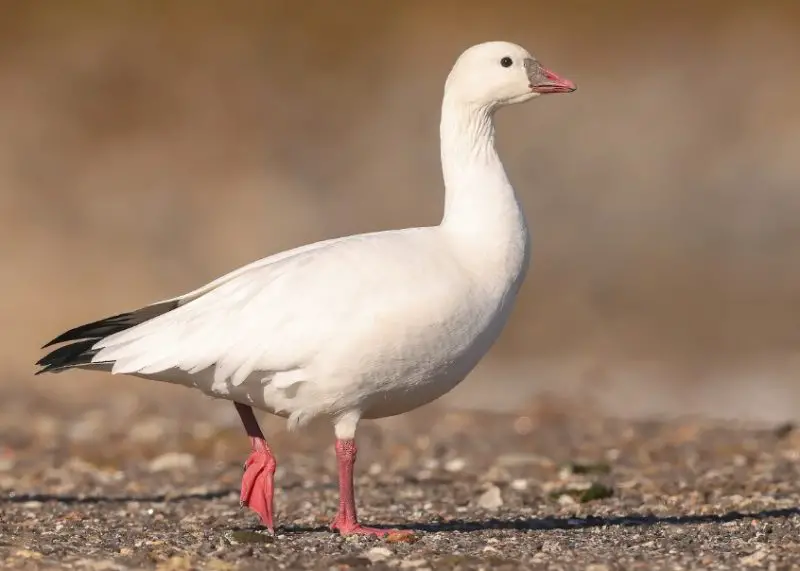
Ross’s Goose is a smaller relative of the Snow Goose, sharing a similar appearance but differing noticeably in size and bill shape. It typically measures 22 to 25 inches in length and weighs about 2.5 to 4 pounds, making it the smallest of North America’s white geese. Its plumage is entirely white with black primary feathers on the wings, and its bill is shorter, stubbier, and lacks the dark “grin patch” seen in Snow Geese. The head appears rounder, and the neck is proportionally shorter, giving Ross’s Goose a compact and graceful look.
In Alabama, Ross’s Goose is an uncommon but regular winter visitor, often found mingling with flocks of Snow Geese. Their behavior is lively and social, especially during migration when they form large, noisy flocks. Despite their smaller size, they are strong flyers and exhibit similar V-shaped migration patterns. They are also known for their distinctive, higher-pitched calls, which sound more squeaky compared to the deeper tones of the Snow Goose.
Ross’s Geese prefer open habitats such as wetlands, shallow lakes, and flooded farmlands where they feed on grasses, seeds, sedges, and agricultural grains. They often graze alongside other waterfowl species and play an important role in maintaining healthy ecosystems by trimming vegetation and dispersing seeds. In Alabama, they are most often spotted during the winter months in the Tennessee Valley region or near agricultural fields that attract migratory geese.
Their breeding grounds lie in the Arctic tundra, similar to those of Snow Geese, where they nest on dry ridges or islands near ponds. The female lays 3 to 5 eggs, incubating them for about three weeks while the male guards nearby. Chicks hatch covered in down and are able to walk and feed almost immediately. Ross’s Geese are remarkable for their strong pair bonds and their synchronized group behavior, which increases the survival rate of their young during long migrations.
Greater White-fronted Goose (Anser albifrons)
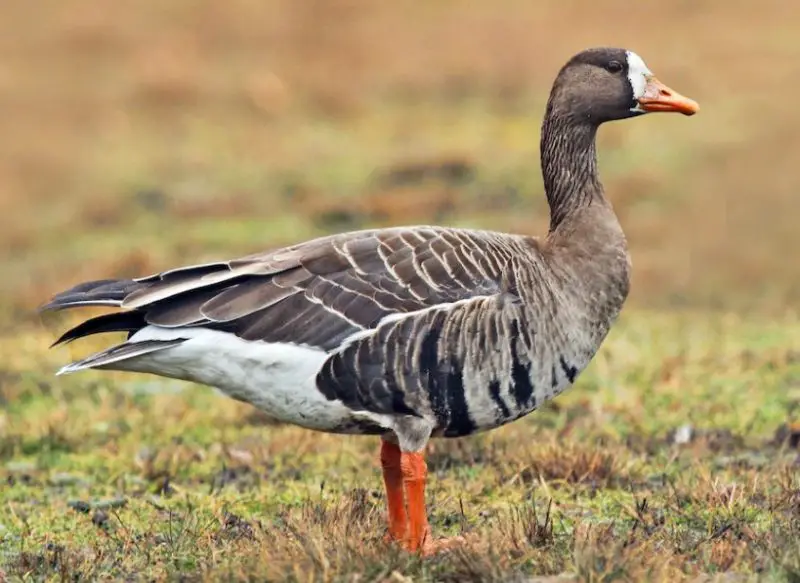
The Greater White-fronted Goose, also known as the “Specklebelly Goose,” is a medium-sized goose easily recognized by its brownish-gray body, orange legs, and the distinctive white patch at the base of its pinkish bill. Adults also have variable black bars or spots on their bellies, which become more pronounced with age, giving rise to the nickname “specklebelly.” This species measures around 26 to 32 inches long, weighs between 4 and 7 pounds, and has a wingspan of up to 55 inches. Its graceful appearance and gentle calls make it a favorite among birders and hunters alike.
These geese are primarily winter visitors in Alabama, especially in the northern and western parts of the state. They are highly migratory, breeding in Arctic Alaska and Canada before moving southward to the Gulf Coast states for wintering. Their flight is strong and direct, and flocks often mix with Snow and Ross’s Geese during migration. They are vocal birds, producing a series of yelping or laughing calls, which differ from the honks of Canada Geese.
Greater White-fronted Geese prefer open habitats such as flooded fields, river valleys, wetlands, and lakeshores. They feed mainly on grasses, seeds, and waste grains, often foraging in agricultural areas during winter. In Alabama, they are often observed in association with rice fields and shallow wetlands where they can graze and rest. They are cautious birds, known to be wary of human presence and quick to take flight if disturbed.
During the breeding season in the Arctic, pairs form long-lasting bonds and return to the same nesting territories each year. Nests are built on dry ground near water, lined with down and grass. Females lay 4 to 6 eggs, incubating them for about 25 days while males stand guard. The goslings grow rapidly, fledging in about 6 to 7 weeks. The strong familial structure and annual migration routes of the Greater White-fronted Goose showcase their impressive adaptability and navigational skills.
Cackling Goose (Branta hutchinsii)
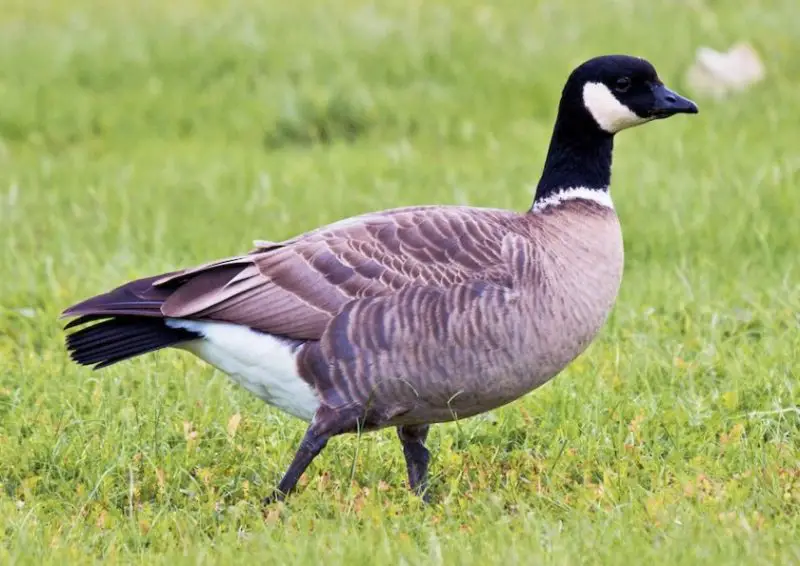
The Cackling Goose is a small, compact relative of the Canada Goose, and it can be challenging to tell them apart at first glance. It measures between 22 and 26 inches in length, significantly smaller than the Canada Goose, and weighs around 3 to 5 pounds. Its short neck, small bill, and proportionally larger head are key identifying features. The plumage pattern is similar—dark brown body, black neck and head, and a white cheek patch—but the voice is notably higher-pitched and more “cackling,” which inspired its name.
In Alabama, the Cackling Goose is a rare and irregular visitor, usually appearing in winter among flocks of Canada or Snow Geese. Its breeding range is primarily in northern Canada and Alaska, and most individuals migrate to the central and southern United States during winter. Despite their small size, they are strong flyers capable of long migrations. Their social behavior mirrors that of their larger relatives, often forming tight-knit family groups that remain together for several months.
Preferred habitats include open water bodies, grasslands, and agricultural fields where they feed on grasses, grains, and aquatic vegetation. They are often seen grazing alongside other geese species. When resting, they may be found on lakes or reservoirs, but they prefer shallow wetlands for feeding. Their adaptability to a range of food sources allows them to thrive in both natural and cultivated landscapes.
Cackling Geese form monogamous pairs that may last for life. During the breeding season in the Arctic tundra, females lay 3 to 7 eggs and incubate them for about four weeks while males guard nearby. The young hatch covered in down and are capable of swimming and feeding within a day. The family group stays together through the migration season. Their compact build, lively behavior, and distinctive vocalizations make the Cackling Goose a charming but infrequent sight for birdwatchers in Alabama.
Brant (Branta bernicla)
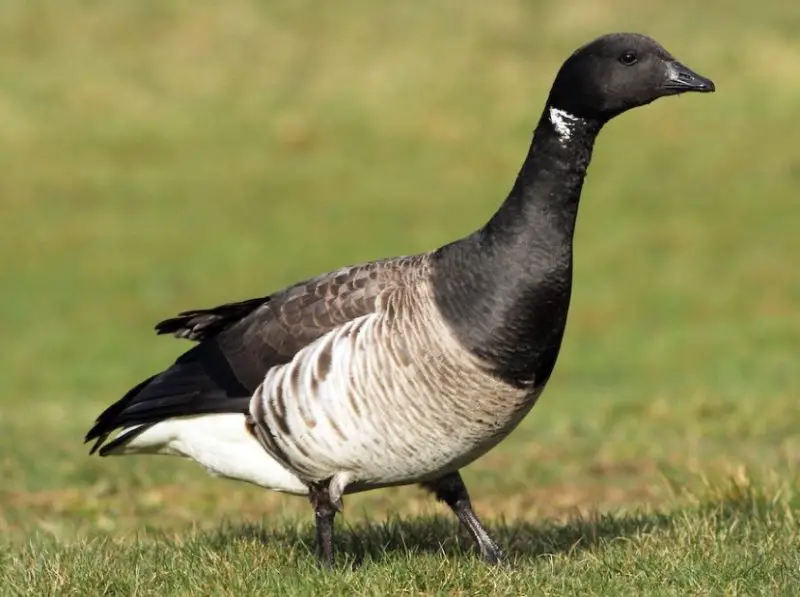
The Brant is a small, compact goose with a distinctive dark appearance that sets it apart from other species found in Alabama. Adults measure about 22 to 26 inches in length and weigh between 3 and 4 pounds, with a wingspan of roughly 42 to 48 inches. Its plumage is primarily blackish-brown with lighter flanks, a short black neck, and a small white patch on the sides of the neck, often described as a “neck collar.” Unlike the Canada Goose, the Brant has no white cheek patch, and its overall darker tone gives it a sleek, elegant look.
This species is primarily a coastal bird, preferring saltwater environments such as bays, estuaries, and tidal flats. In Alabama, sightings of the Brant are extremely rare and usually occur along the Gulf Coast during winter months when individuals stray from their normal Atlantic migratory routes. They feed mainly on eelgrass, sea lettuce, and other aquatic vegetation, often foraging in shallow waters during low tide. During migration, they may occasionally visit inland lakes or reservoirs.
Brant Geese are highly social and form tight flocks both in flight and on the ground. They migrate long distances from Arctic breeding grounds in Canada and Greenland to wintering sites along the eastern seaboard of the United States. Their flight is fast and direct, and they are known for their soft, rolling “rronk” calls that are less harsh than the honks of larger geese. When disturbed, they tend to take off as a synchronized group, creating a spectacular sight.
Breeding takes place in the high Arctic tundra, where nests are built close to freshwater ponds or coastal areas. The female lays 3 to 5 eggs and incubates them for about 24 days, while the male guards the nest. Once hatched, the goslings feed on mosses, sedges, and small aquatic plants. The family groups remain together until migration. Although rare in Alabama, the Brant’s occasional appearance adds a unique touch to the state’s bird diversity.
Barnacle Goose (Branta leucopsis)
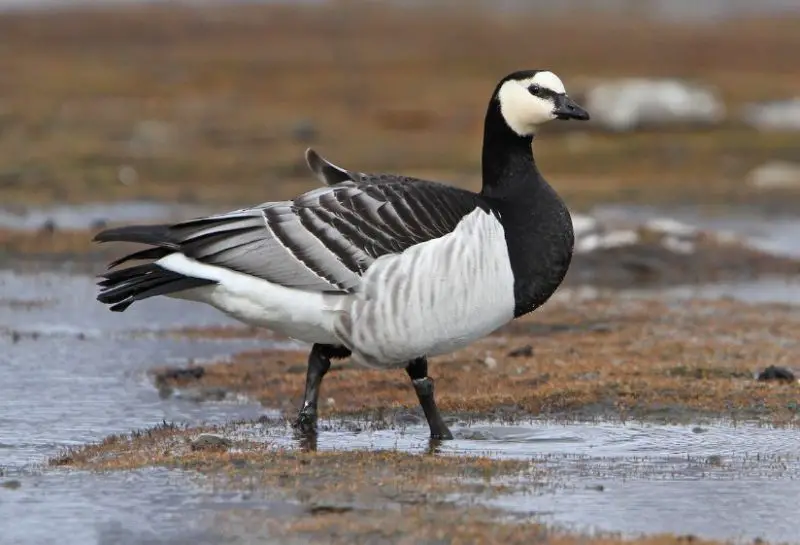
The Barnacle Goose is one of the most visually striking goose species, easily recognized by its crisp black, white, and gray plumage. It measures around 22 to 28 inches long and weighs between 3 and 5 pounds, with a wingspan of about 52 inches. The head and neck are white, contrasting sharply with a black breast and back, while the body shows silver-gray barring. Its short black bill and legs complete the elegant look. Because of its clean coloration, it often stands out among mixed flocks of geese.
This species is considered rare and accidental in Alabama, with only a few documented sightings, usually involving vagrants that have strayed far from their natural range in northern Europe and Greenland. Occasionally, individuals may also escape from waterfowl collections or ornamental ponds, contributing to sporadic local reports. When found in the wild, they often associate with Canada or Snow Geese, feeding peacefully among them.
In their natural range, Barnacle Geese favor coastal habitats, including salt marshes, estuaries, and grassy tundra near the sea. They feed mainly on grasses, mosses, and aquatic vegetation. During migration, they prefer open, flat landscapes that allow for visibility and safety. In Alabama, any observed Barnacle Goose is most likely a wanderer resting in a wetland or farm field before moving on.
Their breeding occurs on cliffs and coastal tundra in the Arctic, where they build nests on ledges safe from predators. Females lay 4 to 6 eggs, and once the chicks hatch, they make a dramatic descent from the cliffs, guided by parental calls. The goslings feed on vegetation near water and fledge within six to seven weeks. Even though rare in the southeastern U.S., the Barnacle Goose’s bold markings and unusual presence make it a remarkable species to encounter.
Pink-footed Goose (Anser brachyrhynchus)
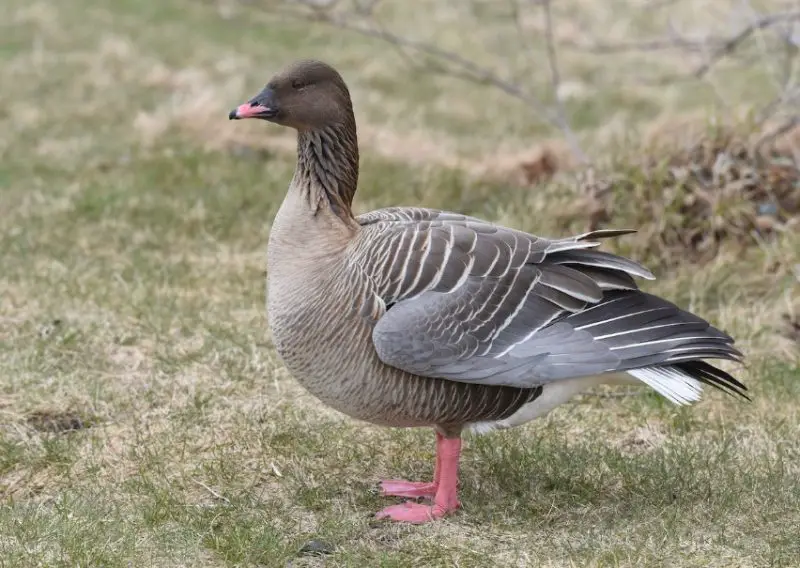
The Pink-footed Goose is a medium-sized Arctic species known for its gentle brownish plumage and distinctive pink legs and bill band. Adults measure 26 to 30 inches long and weigh between 4 and 7 pounds, with a wingspan of about 55 inches. Its head, neck, and upper body are chocolate brown, while the back and wings are gray with pale fringes. The bill is short and dark with a pink band near the middle—one of the best identification features. The overall impression is softer and more delicate than that of its relatives.
This species is very rare in North America and is considered an accidental visitor in Alabama, with only isolated records likely involving trans-Atlantic vagrants. Normally, Pink-footed Geese breed in Greenland and Iceland and winter in northern Europe, especially in the British Isles. When they appear in the U.S., they are typically found among flocks of other migratory geese, often the Greater White-fronted or Canada Geese, where they can blend surprisingly well.
Pink-footed Geese inhabit open landscapes, preferring grasslands, estuaries, and agricultural fields. Their diet consists mostly of grasses, roots, and grains, with occasional aquatic vegetation. In Europe, they are known for feeding on stubble fields and coastal marshes during winter. In Alabama, any sightings would most likely occur in large mixed flocks resting near lakes or farmland during the migration season.
Breeding takes place in the high Arctic tundra, where they nest on cliffs or rocky slopes to avoid predators. The female lays 3 to 5 eggs, incubating them for about four weeks while the male stands guard. The goslings are precocial, able to feed themselves shortly after hatching. The Pink-footed Goose’s long migration journey and its occasional appearance in North America demonstrate the species’ remarkable navigation skills and adaptability to different environments.
Greylag Goose (Anser anser)
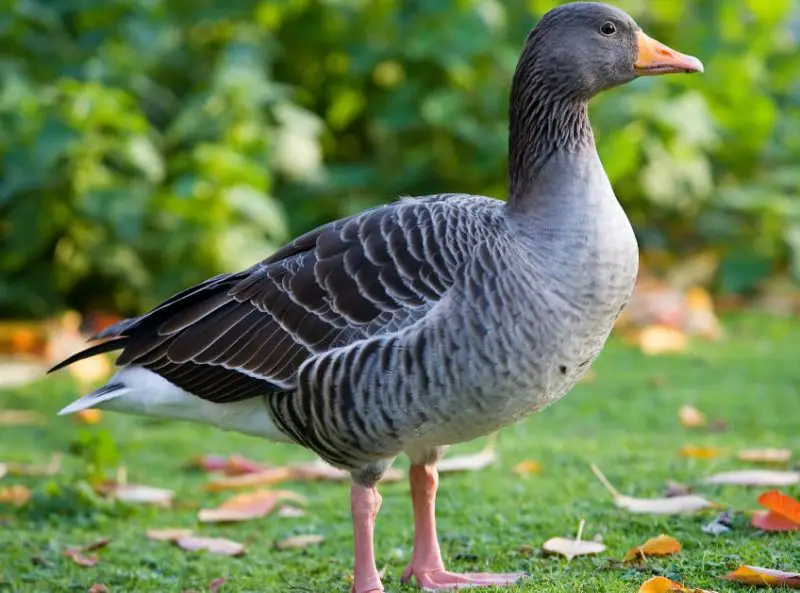
The Greylag Goose is the ancestor of most domestic geese and is easily identified by its robust size and classic gray-brown plumage. It measures 30 to 35 inches in length, weighs between 6 and 11 pounds, and has a wingspan of up to 65 inches. Its body is light gray with darker brown markings on the back and wings, and the bill and legs are orange or pink. The head and neck are slightly darker, and the overall shape is heavyset with a large chest and thick neck.
Although the Greylag Goose is native to Europe and Asia, it occasionally appears in Alabama as an escapee from domestic or ornamental flocks. Feral populations may establish around ponds, parks, and farmlands. These geese are typically non-migratory in such environments, thriving where food and shelter are readily available. Their loud honking calls and social nature make them easily noticed among local waterfowl.
Greylag Geese prefer open, wet habitats such as lakes, ponds, and marshes with surrounding grassy areas. They feed on grasses, roots, grains, and aquatic plants. Their grazing helps maintain open vegetation and prevents overgrowth around water bodies. In Alabama, feral Greylags or hybrids with domestic geese are often seen in city parks or rural farms, sometimes interbreeding with Canada Geese or Domestic Geese.
During the breeding season, females construct large nests on the ground near water using reeds, grass, and down feathers. A clutch usually consists of 4 to 8 eggs, incubated for about 27 days. Both parents guard and guide the goslings, which grow rapidly and can fly within two months. The Greylag Goose’s adaptability and long domestication history have made it one of the most successful goose species worldwide.
Domestic Goose (various breeds, Anser anser domesticus)
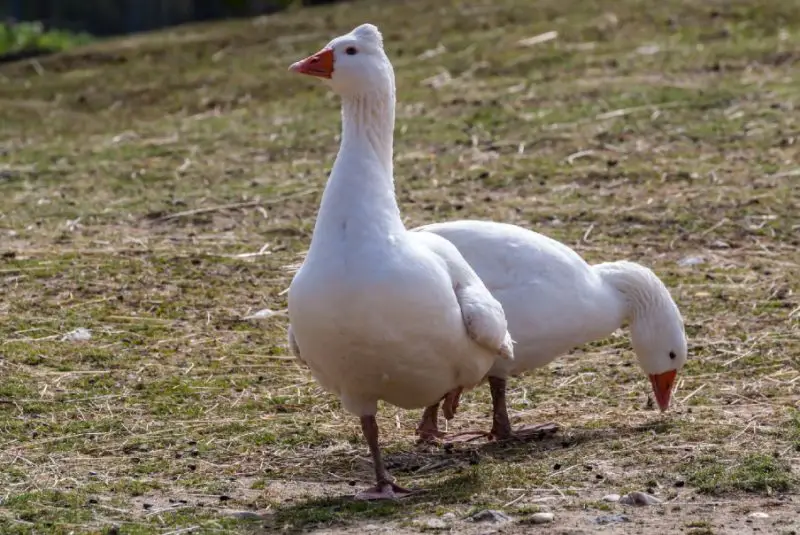
Domestic Geese are descendants of the Greylag Goose and have been selectively bred for thousands of years for meat, eggs, feathers, and companionship. They come in a wide variety of breeds, each with distinct sizes, colors, and temperaments. Common breeds found in Alabama include the Embden, Toulouse, Chinese, and African geese. Their appearance ranges from pure white to gray, buff, or mixed patterns, and adults can weigh anywhere from 10 to over 20 pounds depending on the breed.
These geese are common around farms, homesteads, and urban parks throughout Alabama. They are mostly sedentary and rely on human care for food and shelter, though feral populations can sometimes form in areas where individuals are released or escape. Domestic Geese are herbivorous, feeding on grass, grains, and vegetables. They are social and intelligent, often bonding with other geese or even humans, and are known for their strong protective instincts.
Domestic Geese thrive in open grassy areas near ponds or lakes where they can graze and swim. They are territorial and may become aggressive during the breeding season. Their loud honking serves as both communication and a defense mechanism against intruders. In Alabama’s mild climate, they can breed successfully year-round when provided with proper conditions.
Nesting behavior resembles that of wild geese: the female builds a nest of straw and feathers, lays 4 to 10 eggs, and incubates them for about 28 to 30 days. Goslings are precocial, following their parents soon after hatching. Because of their ease of care and adaptability, Domestic Geese have become a familiar and enduring presence across rural and suburban Alabama, symbolizing a link between wild nature and human cultivation.
Geese Migration and Habitat in Alabama
Alabama provides a welcoming wintering ground for several goose species migrating from the northern tundra of Canada, Alaska, and Greenland. The state’s abundance of wetlands, reservoirs, and agricultural fields offers excellent feeding and resting sites during migration. The Tennessee River Valley, Wheeler National Wildlife Refuge, and the coastal marshes near Mobile Bay are particularly rich areas for observing both resident and migratory geese.
During winter, large flocks of Snow Geese, Greater White-fronted Geese, and Ross’s Geese can often be seen grazing in open fields or resting in shallow water. These gatherings not only attract birdwatchers but also provide important ecological benefits by recycling nutrients through grazing and droppings. Resident populations of Canada Geese have adapted to local environments, thriving year-round in parks, golf courses, and suburban lakes.
Geese typically migrate southward between October and December and return north by late February or early March. Their migrations are guided by inherited instincts and geographical landmarks. In recent decades, warmer winters and human-modified landscapes have encouraged some populations to shorten their migration or stay year-round in Alabama. Understanding these behavioral changes helps wildlife managers balance conservation with human–wildlife coexistence.
If you’re planning to observe geese in Alabama, early mornings or late afternoons are the best times. Bring binoculars, wear neutral clothing, and maintain distance to avoid disturbing feeding or nesting birds. Wetland refuges such as Wheeler NWR, Swan Creek WMA, and Eufaula NWR offer excellent viewing platforms and interpretive trails for visitors.
FAQs About Geese in Alabama
What types of geese can be found in Alabama?
There are at least ten species of geese recorded in Alabama. These include the Canada Goose, Snow Goose, Ross’s Goose, Greater White-fronted Goose, Cackling Goose, Brant, Barnacle Goose, Pink-footed Goose, Greylag Goose, and various Domestic Geese. Some are year-round residents, while others are migratory or rare visitors.
Where can I see geese in Alabama?
The best birdwatching locations for geese in Alabama include Wheeler National Wildlife Refuge, Eufaula National Wildlife Refuge, Swan Creek Wildlife Management Area, and large lakes such as Guntersville Lake and Weiss Lake. Many urban parks and golf courses also host resident populations of Canada Geese throughout the year.
When do geese migrate through Alabama?
Most migratory geese travel through Alabama from October to March, spending the winter months feeding and resting before returning north to breed. Canada Geese, however, are often seen year-round since many populations have stopped migrating due to favorable local conditions.
What do geese eat in Alabama?
Geese are primarily herbivores, feeding on grasses, grains, roots, aquatic vegetation, and leftover crops such as rice or corn. In urban settings, they may graze on lawns or be fed by people, although this is discouraged because it can lead to dependency and health issues.
Are geese protected in Alabama?
Yes. Wild geese fall under the Migratory Bird Treaty Act, which makes it illegal to harm or capture them outside of regulated hunting seasons. Licensed hunting is permitted during specific times of year, while resident nuisance populations can be managed through approved non-lethal methods.
Why are there so many Canada Geese in parks and golf courses?
Canada Geese have adapted extremely well to human-modified landscapes. They prefer open grassy areas with nearby water and few natural predators. As a result, their populations have increased in city parks, suburban neighborhoods, and golf courses throughout Alabama.
Can Domestic Geese interbreed with wild geese?
Yes. Domestic Geese, which are descended from Greylag Geese, can occasionally breed with wild species such as Canada Geese, resulting in hybrids. These mixed birds often appear in parks or farmlands and display traits from both parent species.
How can I identify different geese species in Alabama?
Identification relies on features like size, plumage color, bill shape, and voice. Canada Geese have a black neck with a white chinstrap, Snow Geese are white with black wingtips, and Greater White-fronted Geese have a white facial patch and speckled belly. Observing these traits in good light helps distinguish between species during field sightings.

